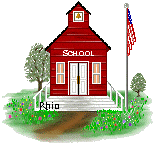Township Index
| Ashton | Belvidere | Center | Cooper |
| Fairview | Franklin | Grant | Jordan |
| Kennebec | Lake | Lincoln | Maple |
| Mapleton | Onawa | Pickle City | Saint Clair |
| Sherman | Sioux | Soldier | Spring Valley |
| West Fork | Willow | Teaching Certificates |
~The above townships are listed per the 1880 Federal Census. Click on linked townships to see further country school data and history. Please feel free to share any rural school information that you may have of your family members who attended Monona County rural schools. Am seeking school stories, school pictures, teacher information. Contact the county coordinator. Thanks so much!
Country Schools The 1st school in the area, a “subscription school,” was at Preparation in 1854 at the Mormon settlement and had young adults as well as children for students. In the 1870s and 1880s districts were formed in each township and school houses were built about 2 miles apart. The school year was, first, 7 months long and divided into summer and winter terms, and later, 9 months, usually starting near Sept. 1 and divided into fall, winter and spring terms. Teachers were hired for one term. The teacher shared “room & board” with the family closest to the school. Strict codes existed about marriage for teachers. While men could marry and have families during their teaching terms, women could not. It should be noted that the names and numbers of school often changed. Architectural Styles of Country Schoolhouses The hip and hip-with-ridge roof styles appeared around the 1920’s. Apparently, the public still preferred the traditional rectangular-shaped schoolhouse, as only a few of the hip schools were constructed. The Bungalow-style appeared in Iowa around 1920. Most of these schoolhouses incorporated the hip or hip-with-ridge roof design. Typically, these schools had column supports for a porch or an attic overhang. By the turn of the century, communities were changing from wood or coal stoves to a furnace system. This created a need for a basement to hold the furnace. Unfortunately, many of the school basements built were not structurally sound, and in their later years, settling unevenly causing much damage and expensive repair to the buildings. Beginning with the Bungalow-style school, these structures had internal accesses to their basements, which housed the furnaces and provided an alternative recreational area to the playground. The earlier schoolhouses had window arrangements of two to four sets of windows on opposing walls for cross lighting. By the early 1920’s, the state superintendent’s office had issued new standards which endorsed the use of a bank of windows on only one elevation. It had been determined cross lighting was harmful to pupil’s eyes. The allowance for light may have played a key role in determining the width of the structure. From measurements, it appears that the formula was consistently in the range of 18-24 foot widths and 28-32 foot lengths for the schools up to the 1920’s. The Bungalow-style schoolhouse, with its hip-with-ridge roof, changed the design to a less rectangular shape. The limited existence of the hip roof structures supports the theory that the preference was for the rectangular building. ~Taken from “Iowa’s Country Schools Landmarks of Learning”, edited by William L. Sherman and published by Mid-Prairie Books, Parkersburg, IA Teacher’s Rules for 1872 Teachers each day will fill lamps, trim the wicks and clean the chimney. Each morning, teacher will bring a bucket of water and a scuttle of coal for the day’s session. Make your pens carefully. You may whittle ribs to the individual taste of the pupil. Men teachers may take one evening each week for courting purposes, or two evenings a week if they attend church regularly. After 10 hours in school, the teacher may spend the remaining time reading the Bible or any other good books. Women teachers who marry or engage in unseemly conduct will be dismissed. Every teacher should lay aside from each pay a goodly sum of his earning for his benefit during his declining years, so that he will not become a burden on society. Any teacher who smokes, uses liquor in any form, frequents pool or public halls, or gets shaved in a barber shop will give good reason to suspect his worth, intention, integrity and honesty. The teacher who performs his labor faithfully and without fault for the years will be given an increase of 25 cents per week in his pay, providing the Board of Education approves. |
